Roman Monuments, Cathedral of St Peter and Church of Our Lady in Trier: Trier is the oldest city in Germany. Trier lies on the banks of the river Moselle. Trier was founded by the Roman Empire in 16 BC. In the 3rd century, Emperor Diocletian made Trier the capital city of the Western Roman Empire and a Roman imperial residence. Trier was the residence of several Roman Emperors and became the Second Rome. Several Roman monuments have survived until the present day. The Porta Nigra (Latin for Black Gate) dates from the 2nd century. Today, the Porta Nigra is the largest Roman city gate north of the Alps. The Roman amphitheatre was built in the 2nd century and was used until the 5th century for wild animal fights and gladiator contests. The Kaiserthermen were once the third largest Roman baths in the world, they were built in the 4th century during the reign of the Roman Emperor Constantine I, also known as Constantine the Great. The Roman Bridge is the oldest bridge in Germany, the pillars were built by the Romans in the 2nd century. The Constantine Basilica (Aula Palatina) was built by Emperor Constantine I in 310. The Constantine Basilica contains one of the largest still existing hall's from antiquity. The Cathedral of St. Peter is the oldest church in Germany, it was founded by Constantine the Great, the first Christian Emperor. The Romanesque Cathedral of St. Peter and the Church of Our Lady in Trier are joined through a passage. The Church of Our Lady was influenced by the French Gothic architecture, such as Reims Cathedral. The Column of Igel is located 8 km upriver from Trier on the river Moselle. Karl Marx was born in Trier in 1818. Now, his birth house is a museum. Trier is situated about 79 km north of the UNESCO World Heritage in Völklingen. The Roman Monuments, the Cathedral of St Peter and the Church of Our Lady in Trier were declared a UNESCO World Heritage in 1986.
www.werelderfgoedfotos.nl © Copyright World Heritage Photos
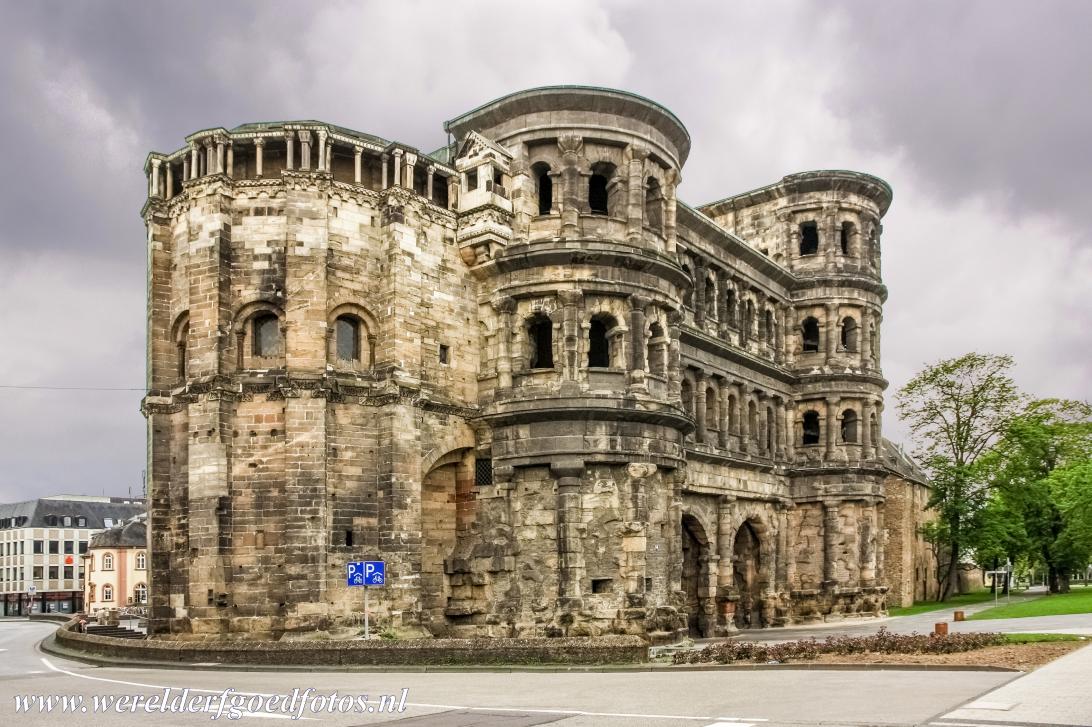
The Porta Nigra is part of the Roman monuments in Trier. The Porta Nigra dates from the 2nd century. The name Porta Nigra (Latin for Black Gate) is due to the darkened colour of its stone. The original Roman name is unknown. The Porta Nigra was the northern city gate of the Roman city Augusta Treverorum, modern Trier. The Roman Monuments, the Cathedral of St Peter and Church of Our Lady in Trier were declared a UNESCO World Heritage in 1986.

The Porta Nigra is part of the Roman monuments in Trier. The Porta Nigra dates from the 2nd century. The name Porta Nigra (Latin for Black Gate) is due to the darkened colour of its stone. The original Roman name is unknown. The Porta Nigra was the northern city gate of the Roman city Augusta Treverorum, modern Trier. The Roman Monuments, the Cathedral of St Peter and Church of Our Lady in Trier were declared a UNESCO World Heritage in 1986.
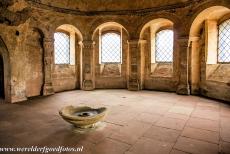
Roman Monuments, Cathedral of St Peter and Church of Our Lady in Trier: The Porta Nigra in Trier. Trier was founded in 16 BC by the Romans and was one of the largest cities in the Roman Empire, it became known as the Second Rome, several Roman monuments have survived until the present day. The Porta Nigra dates from the 2nd century AD, it was built of grey sandstone. Nowadays, the Porta Nigra is the largest Roman city gate north of the Alps.

UNESCO World Heritage Roman Monuments, Cathedral of St. Peter and Church of Our Lady in Trier: The Church of Our Lady in Trier is the oldest Gothic church in Germany, it was built in the 13th century. The floor plan looks like a rose with twelve petals, the Rosa Mystica, the symbol of the Virgin Mary. The Romanesque Cathedral of St. Peter and the Church of Our Lady in Trier, the Liebfrauenkirche, are joined through a corridor.
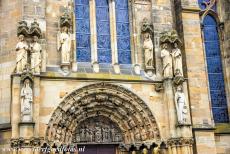
Roman Monuments, Cathedral of St Peter and Churchof Our Lady in Trier: Tympanum above the Main Portal of the High Cathedral of St. Peter in Trier. The cathedral is the oldest church in Germany, the construction started in 326 AD, the cathedral was built on the foundations of the palace of Helena, the mother of Constantine I, the first Christian emperor of the Holy Roman Empire. The cathedral was ruined by the Franks and Normans. Restoration work started in 993.
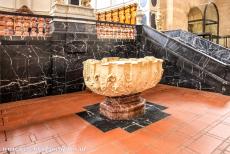
Roman Monuments, Cathedral of St Peter and Church of Our Lady in Trier: The baptismal font of Trier Cathedral. The cathedral is also known as the Cathedral of St Peter. Trier Cathedral was enlarged by major additions in the Romanesque style in the 10th -12th centuries. The adjacent Church of Our Lady was built in the 13th century on the remains of an older basilica. The church and cathedral are joined by a corridor.

The Cathedral of St Peter in Trier is a popular pilgrimage destination, the most precious treasure of the cathedral is the Holy Robe, or Seamless Robe of Jesus, also called the Tunic of Christ. The robe is enshrined in a reliquary housed in the Baroque Chapel of the Holy Robe, situated behind the high altar, most of the chapel remains hidden and not open to tourists. The Tunic of Christ is the robe said to have been worn by Jesus shortly before or during the Crucifixion.
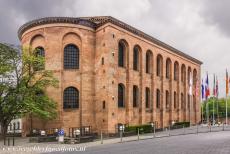
Roman Monuments, Cathedral of St Peter and Church of Our Lady in Trier: The Aula Palatina, or the Constantine Basilica, was built by the Roman Emperor Constantine I in 310 AD, the emperor is also known as Constantine the Great. The Constantine Basilica, also known as Constantine's Throne Room, contains one of the largest surviving hall's from antiquity and was equipped with a floor and a wall heating system. The basilica became a Protestant church in the 19th century.
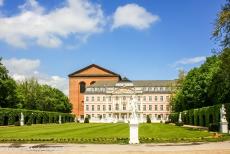
Roman Monuments, Cathedral of St Peter and Church of Our Lady in Trier: The south wing of the Electoral Palace can be admired from the Palace Garden. The palace was built in 1615, next to the Constantine Basilica, the Aula Palatina. The Electoral Palace is considered one of the most beautiful Rococo palaces in the world. A majestic Rococo staircase is situated in the south wing of the palace.
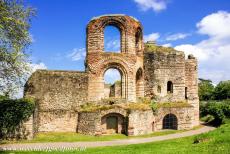
Roman Monuments in Trier: The Imperial Roman Baths, the Kaiserthermen, were built in the 4th century during the reign of the Roman Emperor Constantine the Great. The Kaiserthermen were once the third largest Roman baths in the world, the remains show how huge the complex was. The Kaiserthermen is part of the UNESCO World Heritage Site: Roman Monuments, Cathedral of St Peter and Church of Our Lady in Trier.

Roman Monuments, Cathedral of St Peter and the Church of Our Lady in Trier: The brick tunnels beneath the Imperial Roman Baths, the Kaiserthermen. The bath complex was planned as a gift from the Roman emperor Constantine I to the inhabitants of Trier. The bath complex was never fully completed. Later, the complex was used as a castle and a monastery, it also became part of the city walls. It is allowed to wander through the underground tunnels of the Kaiserthermen.
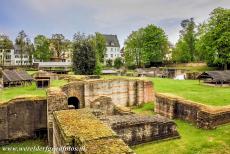
Roman Monuments, Cathedral of St Peter and Church of Our Lady in Trier: The Barbarathermen were built in the 2nd century and were the largest Roman baths at that time. They remained in use for several centuries, but are now in ruins. Only the foundations and tunnels have survived, there is little visible of the impressive size of the Barbarathermen, because it served as a stone quarry for centuries.
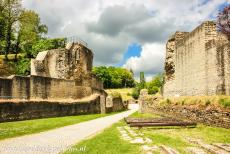
Roman Monuments, the Cathedral of St Peter and Church of Our Lady in Trier: The ruins of the southern entrance gate of the Roman amphitheatre. The amphitheatre was incorporated in the city walls of Trier. In the 5th century, the inhabitants of Trier used the amphitheatre as a refuge from raids by German tribes. In the Middle Ages, it was used as a quarry. Nowadays, the Roman amphitheatre is used for the Antiquity Festival and open-air concerts, the acoustics are perfect.

Roman Monuments, the Cathedral of St Peter and Church of Our Lady in Trier: The Roman amphitheatre is dating from the 2nd century, it was partly dug inside the slope of St. Peter Hill. The slopes were used to sit on. The amphitheatre is surrounded by a stone wall with openings for animal cages. The Roman amphitheatre in Trier was used until the 5th century for gladiator fights and animal contests.

The Roman amphitheatre was built in the 2nd century AD, it could accommodate about 20,000 visitors. Underneath the arena of the Roman amphitheatre is a enormous basement where wild animals, gladiators and criminals were kept prior to their release into the arena, a platform was hoisted to arena level by pulleys. The Roman Monuments, the Cathedral of St Peter and Church of Our Lady in Trier were inscribed on the UNESCO World Heritage List in 1986.
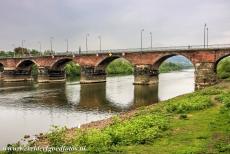
Roman Monuments, Cathedral of St Peter and Church of Our Lady, Trier: The Römerbrücke is a Roman Bridge in Trier, crossing the Moselle River. The Roman Bridge in Trier is 198 metres long. It is the oldest bridge in Germany. The nine pillars of the bridge date from the 2nd century. The upper part of the bridge was originally made of wood, but was later replaced by stone arches, the upper part was renewed in the 12th and 18th centuries.
